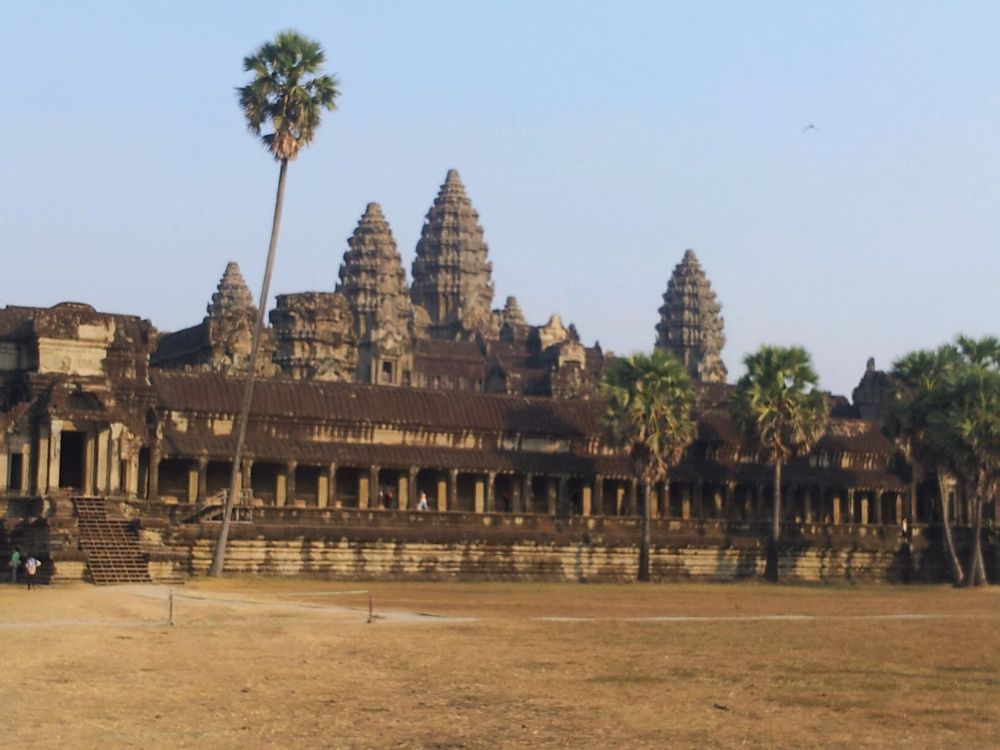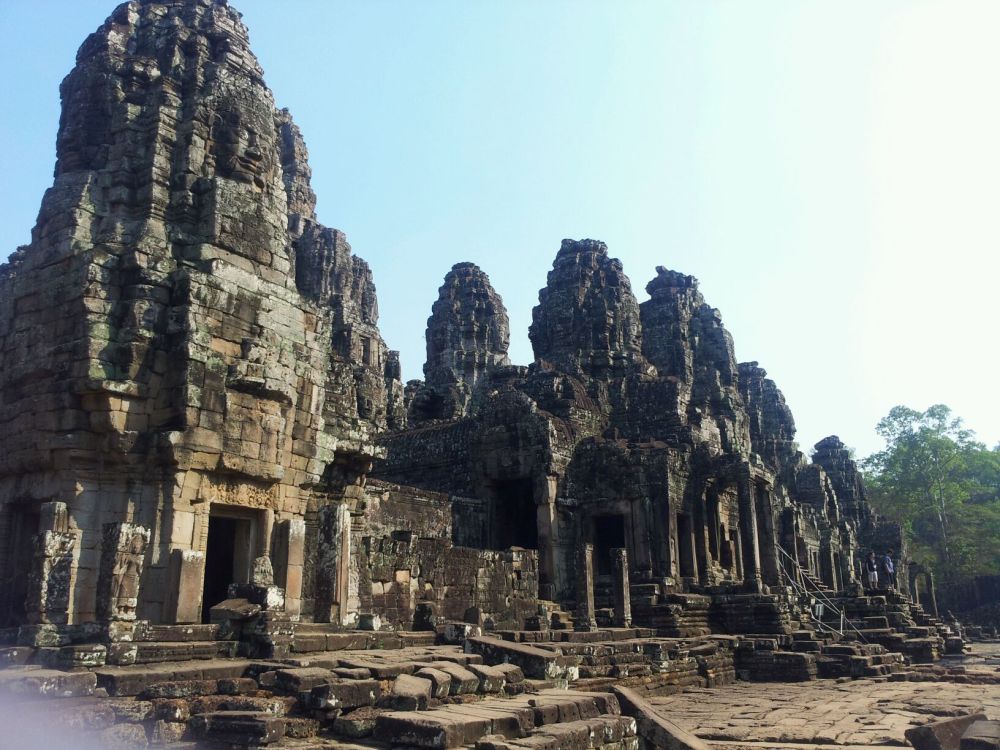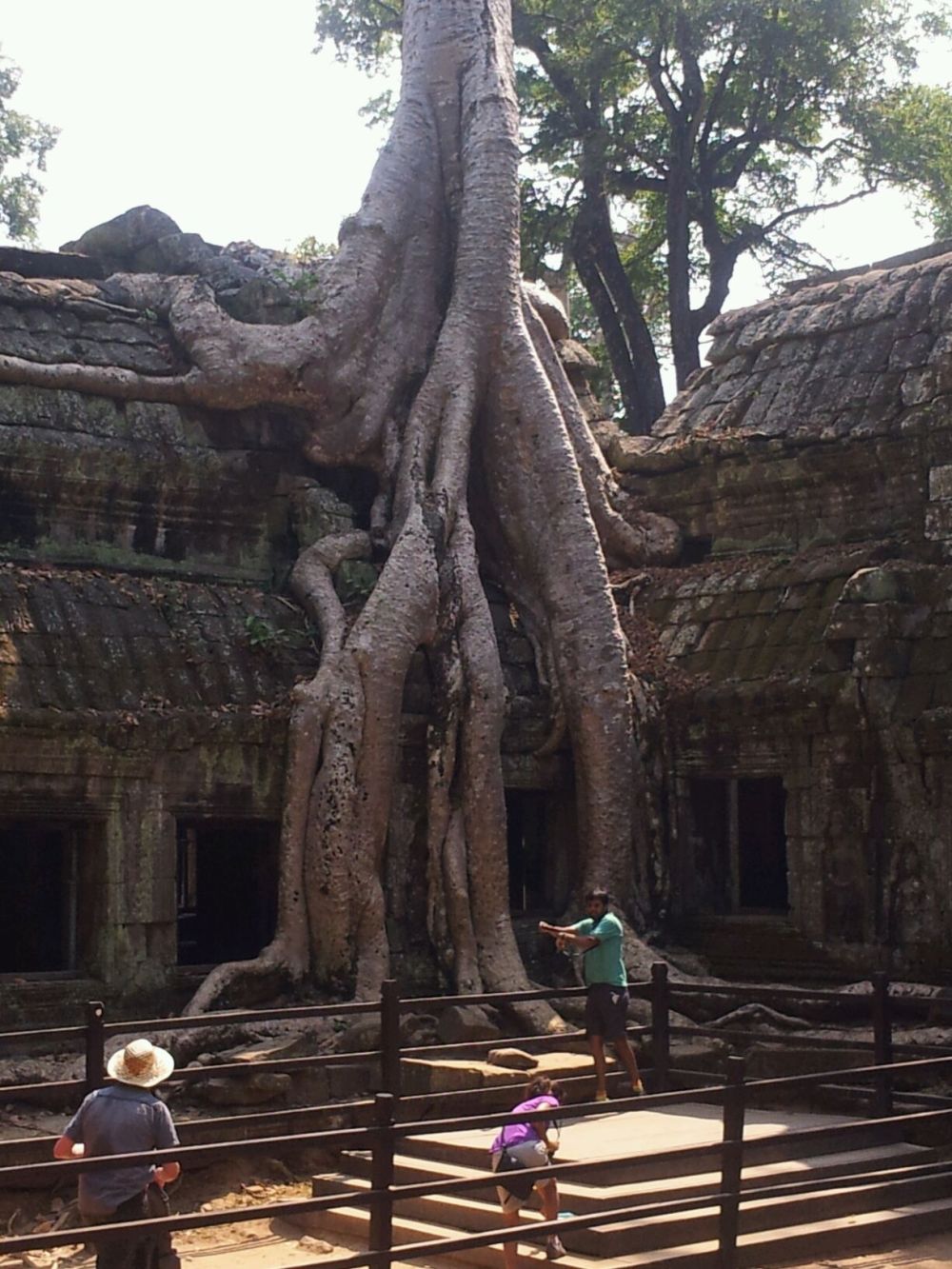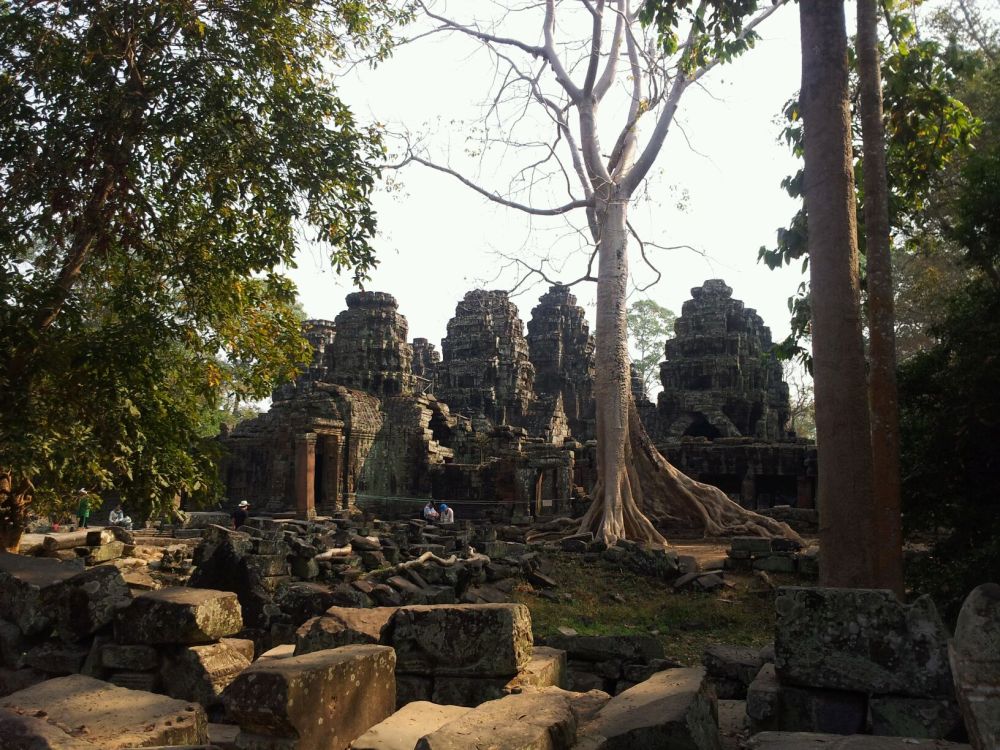FROM Phnom Penh to Siem Reap it’s a mere six hour boatride up the Tonle Sap river into Tonle Sap itself, the largest body of fresh water in South East Asia. One can sit in the suffocating cabin of the desultorarily converted barge, a narrow space with unopening windows, packed with around 70 tourists, aerated only by one feeble fan at the front ; or clamber upstairs and precariously perch on the cabin’s roof. Neither option is without its risks. Stay below and chance falling into a stupor by inadvertently eavesdropping on pony-tailed, washed-up wrinkled hippies’ desperate attempts to relive the Cambodian follies of their decade of peace and love ; sit uptop and suffer the worst sunburn of your life. Charles opts for the latter.
Aside from offering the pleasurable sensation that one is embarked on a Conradian pilgrimage, the river portion of the journey presents varied sights to distract attention from the whiff of sizzling flesh. Birdlife has returned in the form of waders, cormorants, swifts and stilt-like birds. Flocks of terns compete for fish with the thousands of humans who subsist on the Saps : Vietnamese in their floating villages, Cambodians in their on-shore dwellings. These buildings, taking account of the lake’s propensity to swell to five times its size in the rainy season, develop the traditional Khmer stilted house, which raises the living area above ground to create an open working space beneath. Here, some of the houses sit on stilts twenty feet high.
The waters are dotted with pieces of wood, which, attached to submerged nets, are used as floats. As we move upriver and the fishing becomes more intensive, the floats appear in a greater variety of colours and materials. Timber seemingly cribbed from a building site gives way to brightly painted wooden floats ; these in turn are superseded, as we approach the more upwardly mobile sectors of the lake, by gaudy aerosol cans – Pledge and Raid scrape along the bottom of the boat.
Siem Reap literally means ‘Thais defeated’. It has only been Cambodian territory for about 150 years. Its famous temples are witness to the contested status of this region, an area of flux in which Hindu temples become Buddhist places of worship, buildings constructed as vast monuments to one mighty civilisation, the Khemer, are sacked by another, witnesses to the divine favour granted to humanity, are left in ruin, lost to natural forces, and towering structures representing a divine realm dwelt in by gods are given over to that most temporal of activities : the hawking of trinkets.
The first day we take the advice of locals and hire a tuktuk to take us to Bayon temple. Travelling down Boulevard Charles de Gaulle, the wind whips from Charles’ head the porkpie hat for which he forked over too many dong all those weeks ago. Barely a word of protest is uttered, no frantic attempts to get the driver to turn around, no cursing of the tuktuk fates. Is this a new, mellow Charles, I wonder? I promise we will scan the road on the way back in the hope of finding it, but secretly I suspect, if we spot it at all, it will have been utilised by a monkey as a toilet, hence unwearable.
Bayon is really all we can manage in the heat and the few hours we have. A portion of Angkor Wat, the largest religious building in the world, is attempted, but the place is too crowded and there is a fat German in a salmon robe harassing a young wedding couple and their guide on the promenade. “I’m a monk!”, he expectorates, “you can’t touch me. I’m filming you”, he blusters, holding aloft his iPad.

Bayon is similarly infested by humanity. Signs asking visitors to respect the sanctity of the place are ignored by the hordes, who cackle and shriek their way through the holy piece, stopping every few steps to extend a selfiestick and immortalise themselves. One tourist even shuffles me out of the way of his selfie, lest I inadvertently photo-bomb his narcissistic display.
This continual need to assert the self, to snap oneself, to photograph one’s companion posed sultrily beneath a thousand year old lintel, shaping with two fingers an absurd V sign (Korean for lucky, I hear), seems inimical to the surroundings. Here the gods dwelled on earth. It is a place in which the self is obliterated before the vastness of the divine, a site in which the individual ceases to be. It is, in other words, a blessed world in which the selfie does not exist.

The courtyard of Bayon is full of heaps of stones, parts of the temple that have not yet been reassembled. At first I thought the small piles, three or four stones high, were a constructed by devout Buddhists, for I am sure I have seen such towers throughout my travels. While in repose in Bayon, however, contemplating the heaps like a Wordsworth before the ruined Tintern Abbey, I witnessed a couple, both clothed in those sartorially-challenged elephant pants beloved of tourists (so-called, I suspect, not because their designs typically feature pachyderms, but because the pants can only look good on an elephant) create such a tower, take a selfie, then move on.
It is hard to tell how much reconstruction has taken place and some authorities, such as the eminent Dr. Charles, doubt the wisdom of any attempt to resurrect the temples, arguing instead that these sites should have been left as ruins, overrun with jungle.

I disagree, despite counting myself amongst those possessed of a romantic disposition, that noble community who spies great beauty in the majestic ruin.
A few days on we return to the temples, taking in more of Angkor Thom, Ta Prohm (where Lara Croft raided tombs), Angkor Wat again, and several other sites. Phimeanakas’ (four-sided) pyramid is scaled, though the apex sadly lacks the golden pavilion once inhabited by a nine-headed snake who transformed itself into a woman, demanding daily sexual congress with the King, lest the Angkor empire fall into ruin.
For his excursion we hire Chinese bicycles, ignoring the locals warnings about the foolhardiness of the venture. This proves a capital choice. Two wheels give a freedom of itinerary, the chance to stop at will to chat to the monkeys, an opportunity for much needed exercise, and a means to avoid being constantly harassed by tuktuk drivers, whose faces uniformally drop when deprived of the opportunity to yell tuktuk at any passing non-Cambodian.
Their silence is of great comfort to Charles, who to date has taken personally every tuktuk driver’s request, politely taking time to decline each offer with a friendly explanation of why their offer is being declined, a process he follows at every street corner in every town, before, the constant demands of affability proving too much, he snaps, barking at the poor driver to desist. I, on the other hand, ignore the offers and remark upon the apparent male underemployment in this land. Every block of every street is lined by tuktuks, in every one of which lies a driver, either in repose or tapping furiously on his phone. Acknowledging their unhappy circumstance, I still consider their business plan seriously flawed. Surely, if I had need of a tuktuk, I would hail or approach one?, I ask. Even more flawed, perhaps fatally so, is the fact that all most every driver will attempt to charge foreign passengers several times the going rate for a ride, hardly a strategy that encourages uptake of the service.
Outside one temple complex, we are harrangued by sellers. In exchange for one bamboo bracelet I don’t want, which is balanced on my shoulder because I refuse to accept it (“For your wife. Do you have a wife? I find you wife”), I am obliged to enter a dark stall full of woven goods. “This is for your table”, she says, holding up a purple cloth embroidered with a gold Angkor Wat. “I have no table”, I half-truthfully replied. “No. It is for your wall. Don’t tell me you don’t have walls”. Despite the clever sales patter, I am in no mood to purchase, so I cannily turn the conversation around to a dog I spot in the shop’s corner, stuck in that pose – back paw scratching ear- typical of all Cambodian dogs. “What’s his name?”, I ask (for it is obviously a male, desexing of domestic animals being an alien practice here). Following a pause, during which the young woman looks at me incomprehensibly, she sets me straight : “dogs don’t have names”.
Readers may be aware that one of the reasons I am in Cambodia is to attend a wedding. I shall go into no details on the nuptials as the event will no doubt be the focus of an upcoming well-attended Knowledge Sharing session presented by one of the participants. I do, however, feel obliged to announce that sometime during the hens’ night – as a result of general sloppiness or nefarious activity, I know not which – I misplaced my telephone. Henceforth my only means of communication with the outside world – save a message or two via a reluctant Charles – is via the blog. All photographs in this post have been kindly supplied by Charles. And for this, I truly apologise.
